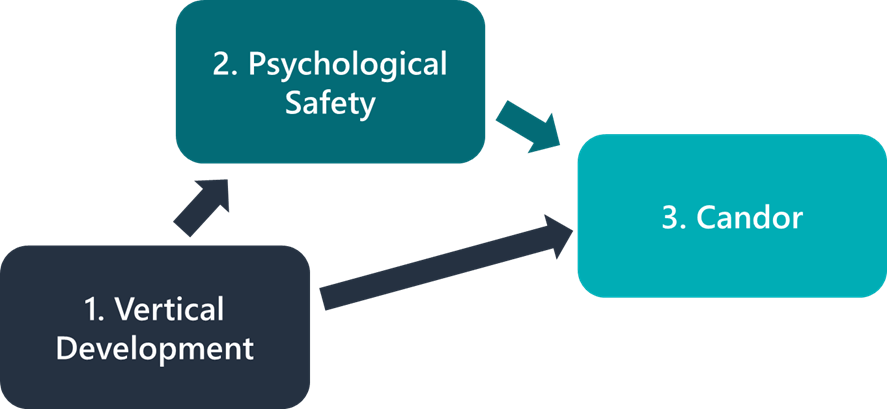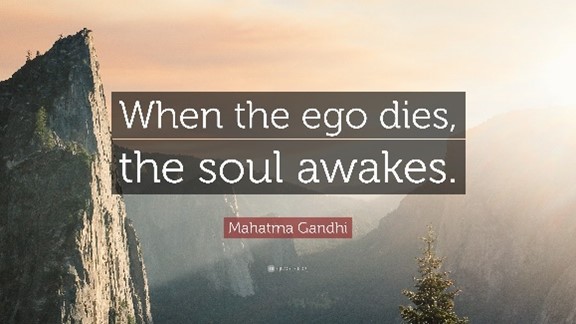If you have been doing any reading of leadership books over the last 10 years (e.g., Creativity Inc., Hit Refresh, No Rules Rules, Radical Candor, etc.), you have read about how the best leaders are able to foster an environment of candor.
What is Candor?
Candor is a willingness in an organization to communicate in an unreserved, honest, sincere, and forthright way.
Why is Candor Important?
Leaders and organizational culture specialists have found that when candor is part of an organization’s culture:
- Ideas, creativity, and innovation flow
- Better decisions are made
- Higher quality coaching occurs
- Employees feel more empowered
- Change more readily occurs (at individual and organizational levels)
- Higher-quality service and products are provided
- Overall, organizations are more successful

When candor is not a part of an organization’s culture:
- Ideas, creativity, and innovation get stuck
- Lower-quality decisions are made
- Coaching is either not present or not effective
- Employees feel controlled
- Change is resisted
- Service and products miss the mark
- Overall, organizations flounder
Knowing this, it is no surprise that leaders and organizational culture specialists are promoting candor with exuberance.
The Two Necessary Ingredients for Candor
There are two necessary ingredients for candor:
- Vertical development
- Psychological safety
To understand why both of these are important, we need to understand what is working against candor.
What Inhibits Candor
In No Rules Rules, a book about Netflix’s culture, written by Erin Meyer (Culture Specialist) and Reed Hastings (Netflix CEO), the authors clearly describe what foundationally inhibits candor:
The brain is a survival machine, and one of our most successful survival techniques is the desire to find safety in numbers. Our brain is constantly on the watch for signals of group rejection, which back in more primitive times would have led to isolation and potentially death. If someone calls out a mistake you are making in front of your tribe, the amygdala, the most primitive part of the brain, which is on constant watch for danger, sets off a warning: “This group is about to reject you.” Our natural animalistic impulse in the face of this is to flee.”
Stated differently, most people come into organizations wired to self-protect. They are wired to hold back out of fear of hurting others feelings. Also, they are wired to have their feelings hurt if someone points something out that they can improve.
This is natural, but it is not very cognitively and emotionally sophisticated.
What Fosters Candor
This is why vertical development and psychological safety are so important:
- Vertical development is the process of upgrading our internal operating system so that we feel less self-protective, expand our window of tolerance for feeling uncomfortable, and become more focused on creating and adding value than fitting in.
- Psychological safety is important because if we want people to move out of self-protection mode and into value creating mode, they must feel psychologically safe. It is nearly impossible to create candor in an environment where employees do not feel psychologically safe.

While most recognize the importance of psychological safety in creating candor, few talk about the necessary and foundational role that vertical development plays in creating candor. In fact, as depicted above, vertical development is even foundational to the development of psychological safety. The reality is that more vertically developed people are more effective at creating environments of psychological safety.
Are You Focusing on Candor?
I am curious, are you, or is your organization, focused on enhancing candor in the environments you live and operate within?
If so, are you talking about vertical development AND psychological safety?
Common Issue
What I commonly find is that organizations are focused on psychological safety, but they are not focused on vertical development. Here is why this matters…
People who aren’t very vertically developed are prone to see safe things as being dangerous and dangerous things as being safe.
We can have a context or culture that is 100% psychologically safe, but that doesn’t mean that employees will feel it is psychologically safe.
For example, in my classes at Cal State Fullerton, I repeatedly am told by students that I do a good job of fostering a psychologically safe environment in my classes. But, I also know that not everyone feels psychologically safe to speak up and comment.
Does this have to do more with me, or with them? Of course, there are always things that I can do to improve psychological safety for everyone. But, something that I have learned is that there is simply some people who will not feel psychologically safe, even if the environment is psychologically safe. This is usually because that person has experienced trauma in their past and has misencoding and window of tolerance issues.
If such people are ever to feel psychologically safe or foster psychological safety, they must first vertically develop, heal from their trauma, improve their encoding processes, and expand their window of tolerance.
My Recommendations
If you want to elevate candor in your workplace, here are my recommendations:
- Bring in and focus on vertical development (Here is a short video introducing the concept).
- Assess employees’ mindsets (this will give you a read on how psychologically safe your culture is). You can take my Personal Mindset Assessment here.
- Read/learn about candor and psychological safety. The books identified at the top of this article is where I would start, and they will give you great ideas on how to foster an environment of psychological safety.










One Response